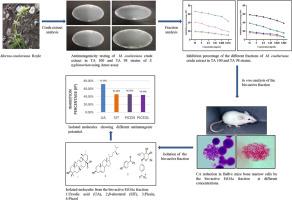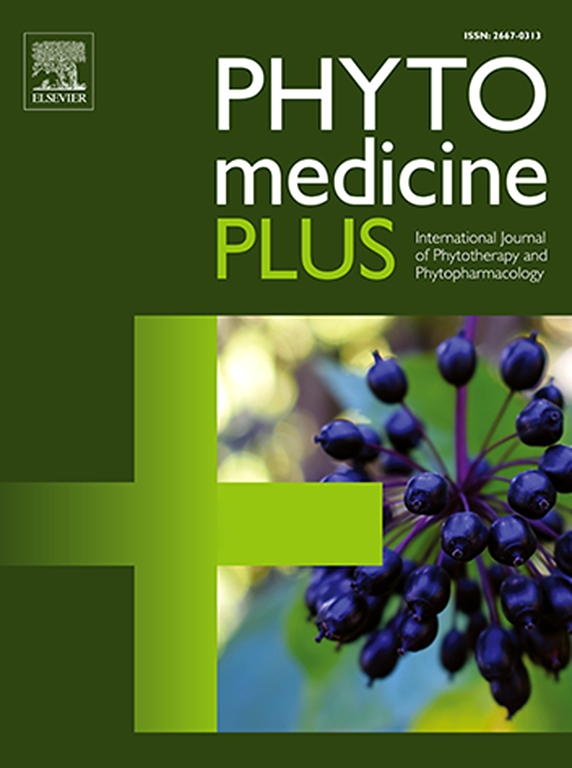以生物测定为指导,从 Morina coulteriana 中分离和鉴定抗突变化合物,并评估其治疗潜力
Q3 Pharmacology, Toxicology and Pharmaceutics
引用次数: 0
摘要
背景在不断扩大的癌症研究领域中,抗突变研究具有广阔的前景。近来,这些研究表明,人们开始关注大自然中的各种菌群及其治疗癌症的潜力。在中国、西藏和印度的传统医学中,桑属植物被广泛用于治疗多种疾病。Morina coulteriana 植物传统上用于治疗眼疾。本研究旨在确定 Morina coulteriana 的抗突变/抗原毒性潜力,并在生物测定指导下鉴定其生物活性成分。方法对甲醇粗提取物及其后续馏分进行体外(艾姆斯试验)和体内(Balb/c 小鼠染色体畸变试验)抗突变/抗原毒性活性测试。对活性(乙酸乙酯)馏分进行了进一步研究,分别利用色谱纯化和详细的光谱技术分离和鉴定其生物活性化合物。乙酸乙酯馏分显示出显著的体外抗突变/抗原毒活性(66.13%)和体内抗突变/抗原毒活性(88.15%)。此外,还发现了四种主要化合物,这些化合物也在体外进行了测试。我们的研究结果表明,该植物具有很强的抗突变性。它以剂量依赖的方式发挥作用,在体外和体内实验中,服用它都能降低细胞的诱变负荷。首次从 Morina 属植物中报告了 2 种分离化合物,即 4hydroxyacetophenone(一种酚)和 picein(一种酚苷)。因此,本研究为探索具有潜在抗突变特性的新植物提供了一个平台。本文章由计算机程序翻译,如有差异,请以英文原文为准。

Bioassay-guided isolation and identification of antimutagenic compounds from Morina coulteriana and evaluation of its therapeutic potential
Background
In the expanding field of cancer research, antimutagenic studies hold a promising ground. In recent times these studies have shown a shift towards the diverse flora of nature and its potential to treat cancer. Genus Morina has been extensively used in Chinese, Tibetan, and Indian traditional medicine to cure numerous diseases. The plant Morina coulteriana has been traditionally used to cure eye diseases. Nevertheless, it has been explored for the first time for its antimutagenic/antigenotoxic potential and phytochemical profile.
Purpose
The present study aimed to determine the antimutagenic/antigenotoxic potential of Morina coulteriana and the bioassay-guided identification of its bioactive constituents.
Methods
The methanol crude extract and its subsequent fractions were tested for antimutagenic/antigenotoxic activity in vitro (Ames assay) and in vivo (Chromosomal aberration assay in Balb/c mice). The active (ethyl acetate) fraction was further investigated to isolate and identify its bioactive compounds utilizing chromatographic purification and detailed spectroscopic techniques respectively.
Results
The results revealed that the plant and its fractions were neither mutagenic nor toxic. The ethyl acetate fraction showed significant antimutagenic/antigenotoxic activity (66.13 %) in vitro and (88.15 %) in vivo. Further, four identified major compounds which were also tested in vitro. Our results revealed that the plant is a potent antimutagen. It worked in a dose-dependent manner and its administration decreased the mutagenic load on the cells both in vitro and in vivo experiments. The 2 isolated compounds viz.; 4hydroxyacetophenone, a phenol and picein, a phenolic glycoside were reported for the first time from the genus Morina.
Conclusion
The findings of the present investigation clearly show that the plant M. coulteriana Royle has a strong antimutagenic potential. Its administration decreased the mutagenic load on the cells both in vitro and in vivo experiments Thus the present study provides a platform for the exploration of new plants with potential antimutagenic properties.
求助全文
通过发布文献求助,成功后即可免费获取论文全文。
去求助
来源期刊

Phytomedicine Plus
Medicine-Complementary and Alternative Medicine
CiteScore
3.70
自引率
0.00%
发文量
178
审稿时长
81 days
期刊介绍:
 求助内容:
求助内容: 应助结果提醒方式:
应助结果提醒方式:


